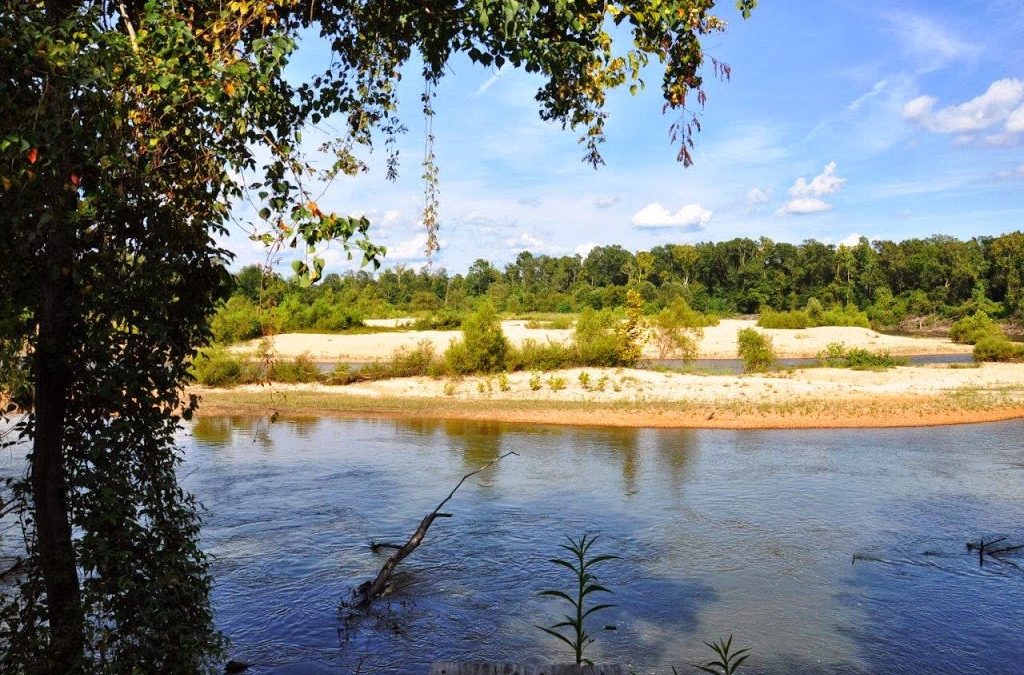
by admin | Sep 22, 2013 | Greater New Orleans
On an unbelievably hot Louisiana summer day, we set out to cool our toes in the waters on the Bogue Chitto River. The state park by the same name is one of Louisiana’s newest state parks, located near Franklinton.
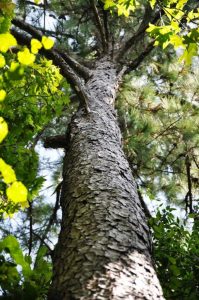 |
| Loblolly pine tree |
The drive there on LA-25 north takes you past some impressive nurseries. However, once you veer off the main road, the landscape felt foreign to us – as if we were suddenly in another state. It appeared to be land that had been clear cut and then let alone to grow back wild, but all the vegetation was still short enough to give the impression of a wide open space. It’s hard to describe, but I had the same feeling as when we drove through the lava fields in Oregon – a bit disoriented.
But then we reached the entrance to the state park, and everything changed again. We drove inside to find a lush, fragrant pine forest, with bluffs and elevation changes similar to Tunica Hills near St. Francisville. Of course, by the time we reached our destination, it was lunch, so we headed straight for the picnic tables. A covered table lent some relief from the glaring sun, and while we shoved bites of sandwiches in the kids’ mouths, they chased grasshoppers and dragonflies with giddy abandonment.
 |
| Boardwalk trail within the gorge |
We vowed to hold out as long as possible before the kids’ drenched themselves in the water, so we started with the hiking trail along the bluff’s ledge. The shaded path was a good 10 degrees cooler than the picnic area and led to stairs that descended deep within the gorge to a lower boardwalk trail. The area down below is known as Fricke’s Cave, although it bears no resemblance to a real cave. It’s unique features led National Geographic to do a story on the area years ago. A collection of Native American arrow heads found in Fricke’s Cave is displayed in the Visitor’s Center.
 |
| Fricke’s Cave |
From here we tried another trail around one of the park’s 11 fishing lakes, where we learned a little about nature from the labeled trees. We also discovered a handful of fossils–tiny imprints of long-ago plants and creatures–in the river rocks scattered about. Not to forget, this was also our first sighting of a velvet ant, which I later learned is not really an ant at all but rather a type of wasp. Who knew?!
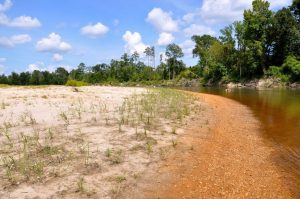 |
| Bogue Chitto River |
By this point, the kids had begged long enough for the water, so we hopped in the car and drove down to the river’s access point. The main parking area was full, so we backtracked to the picnic area and set out from there–following the path through the woods, across the open beach that glared like the Sahara, and finally running full speed into the picturesque river. Several people were milling about on inner tubes, slowly floating downstream while basking–or should I say baking–in the sun. (In case you’re wondering, there is an outfitter in the park that rents the inner tubes.) We stayed long enough for the fish to start nibbling at our toes, and then trecked our way back across the desert for our final destination–the jewel of a water playground.
Not only was there a giant tube slide that dumped the children right into a a long tub of water, but there were streams of water shooting out of the ground and falling out of the sky. While the kids thoroughly drenched themselves, I bought snoballs at the nearby stand as a special treat on our hot summer adventure.
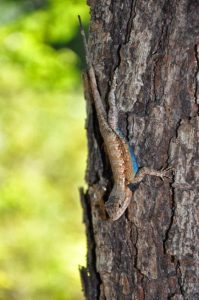 |
| A park native |
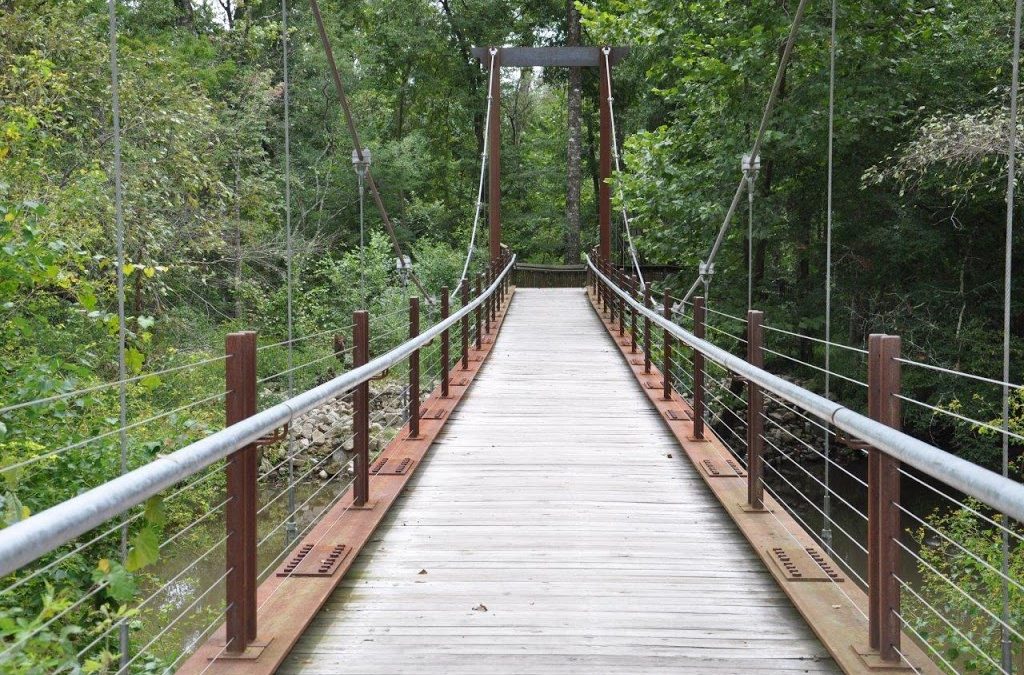
by admin | Sep 3, 2013 | Greater New Orleans
On a whim, we recently decided to take a little drive and check out Tickfaw State Park in Springfield, not far from Ponchatoula and Hammond. It was a scenic journey, north on I-55 through that swampy strip of land sectioning off Lake Maurepas from Lake Pontchartrain. Near Ponchatoula, we headed west into the country, first past some surprisingly large, elegant homes that slowly tapered down to more rustic, rural houses. We passed a few notable spots along the way, including a sign about an old Spanish fort and Springfield’s role in the West Florida Revolution.
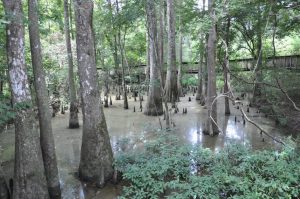 |
| Cypress/tupelo swamp behind the Nature Center |
Once we arrived at Tickfaw State Park, we headed straight to the Nature Center, which the website says houses an 800-gallon aquarium filled with fish from the Tickfaw River. Unfortunately, a posted sign said the Center was closed on Sundays and Mondays, which I assume is the sad result of state park budget cuts. After a quick round of pouting, we perked ourselves up with a picnic lunch and then set off to discover the boardwalk trail leading out from behind the building.
The route began in a quiet cypress and tupelo swamp, where cypress knees extended high above the murky water and skinks were prolific on the boardwalk’s railings. After a short walk, we emerged on dry land in a more traditional forest of hardwood trees. The kids carefully selected walking sticks from the broken branches scattered about, and then we made our way back to the Nature Center where we peaked in the back window and saw the aquarium.
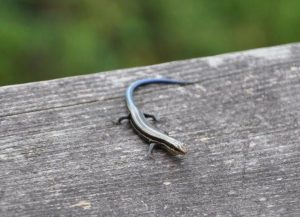 |
| Five-lined skink with blue tail |
Farther back in the park, another trail led us along a boardwalk to a bridge over the Tickfaw River. I thought those striped, blue-tailed skinks had been abundant before, but here they seemed to have taken over the place. Our five-year-old could hardly walk two feet before crouching down to sneak up on the next one. The river was muddy and lazy, winding through a serene stand of trees. We ventured along its banks, spotting countless frogs and water turtles and watching for signs of fish before backtracking to the elevated trail.
Our last stop was the playground, a destination our youngest begs for daily and one we always have to save until the end–or else we’ll never make it anyplace else! So while the kids climbed and slid their way up and over the equipment, we rested on the nearby benches. I was nearly certain the splash park would be next up on the list, but a sudden shower had us instead running for the shelter of the car.
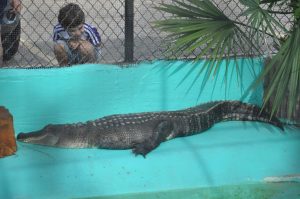 |
| Old Hardhide in Ponchatoula |
To kill time, we drove the streets back toward the entrance, veering off here and there to see what we had missed along the way. This is how we found ourselves at a small pond, walking the circular trail around its perimeter and watching with wide-eyed wonder as the resident alligator swam along beside us.
With alligators on the mind, we had to stop on our way out in Ponchatoula, where Old Hardhide lives in his cage in the middle of downtown. He was relaxing on the side of his pond, silently snoozing while we snapped photos of the kids squatting only a foot away on the opposite side of his chainlink fence. Next door, the old town depot from 1894 beckoned us inside with the promise of arts, crafts and antiques. The kids talked us into buying them toy alligator head grabbers in return for them smiling for a photo in front of the old locomotive across the street.
 |
| Middendorf’s Restaurant |
For the day’s finale, we pulled off the interstate in Manchac for some of Middendorf’s famous thin-fried fish. We ate our fill and followed it up with homemade ice cream before taking our leftover bread outdoors to feed the seagulls. While we stood there on the small pier with birds circling our heads, a train barreled past, flying across its narrow bridge over Lake Maurepas. By now, the kids had discovered the giant sand pit behind the restaurant and set up shop next to the palm trees, building tiny villages with toy trucks and buckets. I’ll only say it was “difficult” to persuade them to leave. Yet, as the sun set over the tiny fishing village, reflecting off the water and highlighting the floating lily pads, we all smiled at the beauty of this place that was so perfectly Louisiana.
 |
| Manchac |












